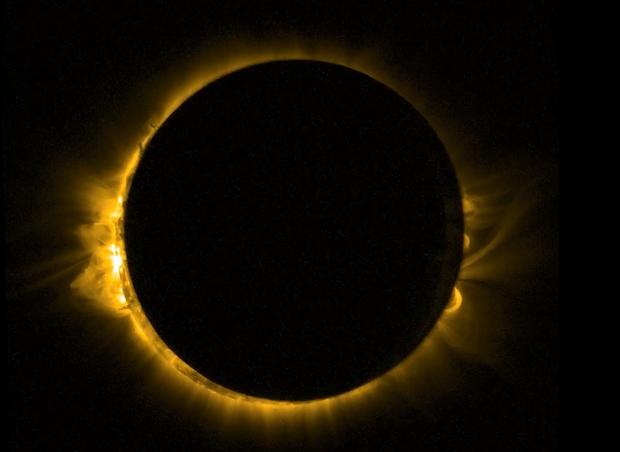The best views of the total solar eclipse
Sky-gazers in the Arctic were treated to a perfect view of a total solar eclipse Friday as the moon completely blocked out the sun in a clear sky, casting a shadow over Norway's remote archipelago of Svalbard.
But for those of us who weren't able to make it to the tiny islands in the north of Europe that played host to the exclusive display, there are fantastic videos and beautiful pictures to revel in. There's also one viral image that has tricked a lot of hopeful web watchers into thinking they saw something they didn't.
People shouted, cheered and applauded as Longyearbyen, the main town in Svalbard, plunged into darkness. The skies were clear, offering a full view of the sun's corona - a faint ring of rays surrounding the moon - that is only visible during a total solar eclipse.
A few hundred people had gathered on a flat frozen valley overlooking the mountains, and people shouted and yelled as the sudden darkness came. A group of people opened bottles of champagne, saying it was in keeping with a total solar eclipse tradition.
"I was just blown away. I couldn't believe it," said Hilary Castle, 58, from London.
"It was just fabulous, just beautiful and at the same time a bit odd and it was too short," said Mary Rannestad, 60, from Minnesota.
A solar eclipse happens when the moon lines up between the sun and the Earth. This casts a lunar shadow on the Earth's surface and obscures the sun. During a partial eclipse, only part of the sun is blotted out.
Though some enterprising eclipse-seekers got exactly what they were hoping for, others were less lucky. A blanket of clouds in the Faeroe Islands in the North Atlantic blocked thousands of people from experiencing the full effect of the total eclipse.
The Faeroes and Svalbard were the only two places on land where the eclipse was total. About 20,000 visitors had traveled to the two remote island groups to watch the spectacle.
Despite the clouds in the Faeroes, tourists and residents in Torshavn alike hooted and applauded as the daylight dimmed for about 2 minutes and 45 seconds.
"It was a pretty big disappointment not to be able to see the sun," said Janaki Lund Jensen, who had sailed from Copenhagen with 884 others to see the eclipse. Hotel rooms have been booked for years as thousands came to the Faeroe Islands to try to see the eclipse.
Sigrun Skalagard, in the northern parts of the Faeroes, said birds there went silent and dogs started howling.
"Some people were surprised to see how fast it became dark," she said.
A partial solar eclipse could be seen Friday across Europe and parts of Asia and Africa. Britain's Met Office said 95 percent of the sun was covered in the Hebrides, Orkneys and Shetland Islands, and one percent less further south in Glasgow and Edinburgh.
In Copenhagen, the sun was 85 percent covered up while 80 percent was hidden in southern Sweden. Cloudy weather put a lid across large parts of the continent, making it hard to see the eclipse. However, a thin cloud cover allowed people in Stockholm to watch the eclipse without protective glasses, as the faint disk of the sun could be seen through the overcast sky.
As CBS News correspondent Charlie D'Agata reported from London, hopeful watchers there didn't need their protective glasses. The clouds were too thick to see much of anything at all.
Meanwhile, the European Space Agency's Sun-watching Proba-2 minisatellite got a breathtaking view from orbit, more than 400 miles above Earth:
That image is real. This next one, however, is not.
A photo of the eclipse supposedly taken from aboard the International Space Station, with Earth below and the Milky Way in the background, went viral on Twitter Friday. It turned out to be a fake.
As Gizmodo reported, it is a 3D rendering made by a user on the site DeviantArt. The Milky Way was added later in Photoshop.
The last total eclipse was in November 2012 over Australia. The next one will be over Indonesia in March 2016, according to NASA.


